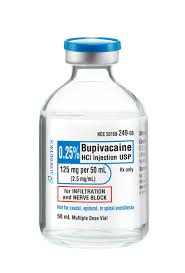Bupivacaine is the active substance of an anesthetic medicine known commercially as Novocaine.This injectable drug is indicated for local anesthesia, especially before simple surgeries. Its action is to inhibit the conduction of nerve impulses to the brain thus reducing the perception of pain.
Common Uses of Bupivacaine
Local or regional anesthesia or analgesia in surgical procedures (including oral surgery), diagnostic and therapeutic procedures, and obstetric procedures.
- Bupivacaine will be given to you by a doctor with the necessary knowledge and experience in the epidural anesthetic technique.
- The medicine is for single use only.
- The medicine may be given before surgery (smaller or larger) or during labor.
- In minor surgeries, the injection will be given near the operation site on the body.
- The medication will prevent the pain and cause numbness that will gradually disappear after the end of the operation.
- In larger surgeries or deliveries you may be given an injection in the back that will take a few minutes.
- This will prevent pain and cause numbness in the lower body, lasting normally 3 to 4 hours.
- In most cases, one dose is sufficient but other doses may be necessary if the surgery is prolonged.
Bupivacaine Side Effects
Anxiety; somnolence; dizziness; tremor; blurred vision; decreased pressure;arrhythmia; respiratory paralysis; decreased ventilation.
Contraindications of Bupivacaine
Pregnancy risk C ; women in the lactation phase; children under 12 years of age;Hipersensibility to any of the formula’s components.
Bupivacaine Use mode
Adults
- Lumbar region : Apply 50 to 100 mg (10 to 20 ml) of Bupivacaine. Give additional doses of 3 to 5 ml.
- Caudal region : Apply 75 to 150 mg (15 to 30 ml) of Bupivacaine.
| Very common (> 1/10) |
Gastrointestinal disorder: nausea |
| Common (> 1/100 <1/10) |
Gastrointestinal disorder: vomiting Urinary and renal disorders: urinary retention, urinary incontinence |
| Uncommon (> 1/1000 <1/100) |
Musculoskeletal disorders of connective tissue and bone: muscle weakness, low back pain |
| Rare (<1 / 1,000) |
Immune system disorders: allergic reactions, anaphylactic shock Nervous system disorders: total involuntary spinal block, paraplegia, paralysis, neuropathy, arachnoid Respiratory tract: respiratory depression |

